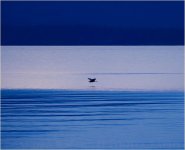You are using an out of date browser. It may not display this or other websites correctly.
You should upgrade or use an alternative browser.
You should upgrade or use an alternative browser.
Random Object Photographs
- Thread starter opaul
- Start date
THE PILGRIM
Member

Took this one on 12/27/2024: Auschwitz-Birkenau. It is actually in color but it was frosty and had dense fog. Here is some info.
Construction of Auschwitz II began in September 1941, and from 1942 until late 1944 freight trains delivered Jews from all over German-occupied Europe to its gas chambers. Of the 1.3 million people sent to Auschwitz, 1.1 million were murdered. The number of victims includes 960,000 Jews (865,000 of whom were gassed on arrival), 74,000 non-Jewish Poles, 21,000 Romani, 15,000 Soviet prisoners of war, and up to 15,000 others. Those not gassed were murdered via starvation, exhaustion, disease, individual executions, or beatings. Others were killed during medical experiments.
At least 802 prisoners tried to escape, 144 successfully, and on 7 October 1944, two Sonderkommando units, consisting of prisoners who operated the gas chambers, launched an unsuccessful uprising. After the Holocaust ended, only 789 Schutzstaffel personnel (no more than 15 percent) ever stood trial. Several were executed, including camp commandant Rudolf Höss. The Allies' failure to act on early reports of mass murder by bombing the camp or its railways remains controversial.
As the Soviet Red Army approached Auschwitz in January 1945, toward the end of the war, the SS sent most of the camp's population west on a death march to camps inside Germany and Austria. Soviet troops entered the camp on 27 January 1945, a day commemorated since 2005 as International Holocaust Remembrance Day. In the decades after the war, survivors such as Primo Levi, Viktor Frankl, Elie Wiesel, and Edith Eger wrote memoirs of their experiences, and the camp became a dominant symbol of the Holocaust. In 1947, Poland founded the Auschwitz-Birkenau State Museum on the site of Auschwitz I and II, and in 1979 it was named a World Heritage Site by UNESCO. Auschwitz is the site of the largest mass murder in a single location in history.
Last edited:
"Man's inhumanity to man', writ very large...After the Holocaust ended, only 789 Schutzstaffel personnel (no more than 15 percent) ever stood trial. Several were executed, including camp commandant Rudolf Höss....
Have you seen Zone of Interest? Chilling. Filmed in an empty house just down the road from Höss's own house, which the production crew painstakingly rebuilt to be as close to the original as possible, and filmed in natural light, with the cameras and microphones hidden to avoid distraction.
Höss's eldest daughter, Hannah, just died recently. Her story is interesting. After the war she worked as a fashion model, emigrated to the US and worked for a fashion company - owned by Jews. At a party she let slip that she was Höss's daughter. But the owner took her aside and said, "It doesn't matter. You are not responsible for what your father did. You are welcome here." Wow...
There was this article in the NYT a few years ago (free link)
David Dushman, Soviet Soldier Who Helped Liberate Auschwitz, Dies at 98
Mr. Dushman is believed to have been the last surviving liberator of the camp.

"Man's inhumanity to man', writ very large
Have you seen Zone of Interest? Chilling. Filmed in an empty house just down the road from Höss's own house, which the production crew painstakingly rebuilt to be as close to the original as possible, and filmed in natural light, with the cameras and microphones hidden to avoid distraction.
Höss's eldest daughter, Hannah, just died recently. Her story is interesting. After the war she worked as a fashion model, emigrated to the US and worked for a fashion company - owned by Jews. At a party she let slip that she was Höss's daughter. But the owner took her aside and said, "It doesn't matter. You are not responsible for what your father did. You are welcome here." Wow...
I did see the movie...just two weeks ago. Very well done and chilling. Höss was executed by hanging. The Soviets killed him in 1947 just next to the gas chamber of Auschwitz I. The museum had recreated the scaffold at the location of the execution.
Last edited:
^^A Day in the Life^^
THE PILGRIM
Member

This complex was not marked on any map. Its existence was known to only 12 people in Poland. Facility 3001 in Podborsko was meant to provide nuclear support to the Polish army during the Cold War. On February 25, 1967 an "Agreement between the Polish Government and the Soviet Government concerning measures taken with respect to the increase in the army's operational readiness" was signed in Moscow. It was agreed that three special facilities would be built by November 1, 1969. Each of the facilities would have two special storehouses, where nuclear weapons and assembly teams and the necessary auxiliary infrastructure were housed. The parties agreed that the Soviet Government would design the special storehouses, and provide the special technical equipment necessary to control, assemble, and handle nuclear weapons. The Polish side was to cover the costs of the construction of the facility, engineering networks, and all buildings and installations. On July 6, 1967, the Polish Minister of Defense, General Wojciech Jaruzelski, signed the "instruction on the protection of construction of facilities for communications units." It was assumed that "Plan 3001" (the name used for the investment plans related to the construction of three complexes), was a top state secret. The investment was formally carried outfrom June 27, 1967 to August 21, 1969. The cost of construction of Facility 3001 in Podborsko amounted to 68.3 million Polish zloty. In each bunker there is a loading chamber connected to four nuclear weapons storehouses. Each storehouse could accommodate up to 20 warheads and nuclear bombs; 160 nuclear warheads total. The facility was guarded by Soviet Spetznatz troops and was considered sovereign Soviet soil. The existence of these three facilities was kept secret from the Polish people except for the 12 Poles high in government.

The Dornier Do 335 was one of the fastest propeller-driven aircraft ever flown. The Germans claimed that a pilot flew a Do 335 at a speed of 846 km/h (474 mph) in level flight at a time when the official world speed record was 755 km/h (469 mph). Two liquid-cooled engines each developing about 1,750 hp powered the Do 335. Dornier mounted one engine in the nose and the other in the tail in a unique low-drag push-pull configuration. This innovative design also featured an ejection seat, a tail fin which the pilot could jettison, and tricycle landing gear. For a fighter airplane, the Do 335 was enormous: tall enough that a person of normal height could walk beneath it and very heavy at 9,600 kg (21,000 lb) loaded. Serious flaws also plagued the design. The rear engine overheated often and the landing gear was weak and prone to failure.
Claudius Dornier patented the push-pull engine layout in 1937, which was innovative because it offered the power of two engines but less drag and greater maneuverability than other twin-engine configurations. The RLM (German Aviation Ministry) wanted to support development of push-pull aircraft but initially only as seaplanes and bombers. By 1942, the Luftwaffe needed multi-role fighters and after submitting a proposal in January 1943 for a Schnellbomber (fast bomber), Dornier built a prototype Do 335 V-1 ('V' for Versuchs or experimental) and the aircraft completed its first flight in September 1943. Following initial testing, the RLM ordered 14 prototypes, ten preproduction aircraft with the suffix designation A-0, eleven production A-1 single-seat aircraft, and 3 A-10 and A-12 two-seat trainers.
Dornier selected two Daimler-Benz DB-603 V-12 cylinder engines to propel the four different versions of the Do 335. Each engine displaced 44.5 liters (2,670 cu in) and weighed 910 kg (2,006 lb). Unlike conventional twin-engine aircraft with wing-mounted engines, the Do 335 would not yaw sharply to one side if one engine failed, and single-engine flying speed remained respectable at about 620 km/h (345 mph). Pilots reported exceptional flight performance in acceleration and turning radius, and docile handling with no dangerous spin characteristics. In an emergency, however, the pilot could detonate explosive bolts and jettison the pusher three-blade propeller and dorsal fin to increase the chances of successfully bailing out using the pneumatic ejection seat. When fired, the seat pushed the pilot away from the aircraft with a force of about 20 Gs.
Dornier finished building as many as 48 Do 335 airplanes and another nine or so were under construction when the war ended. One of many plans issued by the RLM called for Dornier to build 310 Do 335s by late 1945. Although combat conversion units received several pre-production aircraft about 10 months before the war ended, no pilots flew Do 335s in combat. Only one example of the first production version Do 335A-1 rolled off the Dornier assembly line at Friedrichshafen just before the war ended. One 30 mm MK-103 cannon (70 rounds were carried) firing through the propeller hub and two 15 mm MG-151/15 cannon (200 rounds per gun) firing from the top cowling of the forward engine armed this model, and an internal bomb load of 500 kg (1,100 lb) could be carried.
The NASM displays at the Steven F. Udvar-Hazy Center the second Do 335 A-0 built. Dornier designated this airframe construction number 240102 and gave it the aircraft identification code VG + PH and A-02. Crafts persons completed the aircraft at Dornier's plant at Mengen, Germany, on 30 September 1944, and then test-flew the airplane during the winter of 1944-45. From 20-23 April 1945, German test pilot Hans Werner Lerche flew the Do 335 from Rechlin back to Oberpfaffenhofen near Münich, via Prague, Czechoslovakia, and Lechfeld, Germany. Allied forces found the Do 335 at Oberpfaffenhofen on April 29.
In mid-June, pilots ferried two Do 335s, including the NASM aircraft piloted by German test pilot Hans Padell, from Oberpfaffenhofen to Cherbourg, France, for shipment to the USA aboard the British aircraft carrier HMS Reaper. Following testing from 1945-48, the U. S. Navy transferred the Do 335 to the Smithsonian's National Air Museum in 1961. The Do 335 remained stored at Naval Air Station Norfolk until 1974 when the Smithsonian returned it to Oberpfaffenhofen, Germany, where the Dornier company preserved and restored the airplane in 1975. Dornier crafts persons, many of them factory employees since World War II, were surprised to find still attached to the aircraft the explosive bolts designed to blow off the tail fin and rear propeller. Dornier displayed the preserved airplane at the May 1976 Hannover Airshow, and then moved the artifact to the Deutsches Museum in Munich until the aircraft was returned to the Paul E. Garber Facility for storage in 1986.
Similar threads
- Replies
- 5
- Views
- 187














